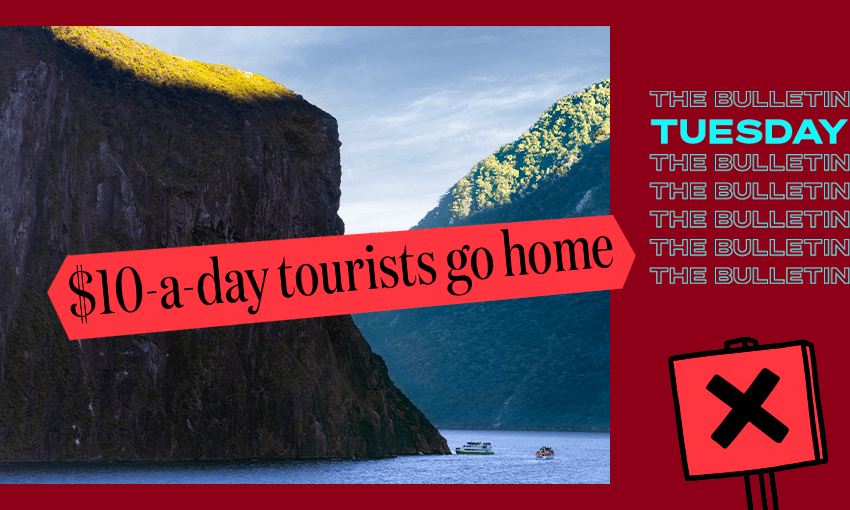Are big-spending tourists best for New Zealand?
Tourism minister Stuart Nash is once again pitching New Zealand to high value tourists, but is that the best course for the environment and a sector in recovery?
Mōrena and welcome to The Bulletin for Tuesday, August 16, by Anna Rawhiti-Connell. Presented in partnership with Z Energy.
In today’s edition: Aucklanders need to halve their driving in eight years; 120 defence staff will be deployed to the UK to assist in training Ukrainian soldiers; a year since the fall of Kabul; but first, no more $10-a-day tourists?
Tourim minister Stuart Nash says we won’t be seeking to attract $10-a-day tourists (Image: Getty/Tina Tiller)
$10-a-day tourists go home?
Given everything that was going on last week, it’s possible reaction to tourism minister Stuart Nash’s comments last week about the kinds of tourists we are seeking to attract, got slightly overlooked here. Or maybe everyone agrees that we don’t want “people who put on Facebook how they can travel around our country on $10 a day eating two-minute noodles” visiting New Zealand? Nash made the comments at the launch of a draft plan focused on strengthening tourism and hospitality workforces. The sentiment also isn’t new. Nash made comments in 2020 that New Zealand would “unashamedly” target the wealthy – the type of tourist who “flies business class or premium economy, hires a helicopter, does a tour around Franz Josef and then eats at a high-end restaurant.”
Global grappling with tourism
There’s no doubt that tourist destinations all over the world are rethinking tourism and trying to balance concerns about conservation, climate change, economic recovery and quality of life for residents who live in tourist hotspots. In Venice, residents report feeling “suffocated” by an “economic machine” that has focused on tourism. These issues also pre-date the pandemic. The line in today’s feature image is a blatant rip-off of sentiment being expressed all over Barcelona in graffiti form in 2017 and 2018. Closer to home, Crux’s new documentary series which so far has spotlighted the future of tourism in the Milford Sound and disagreements about the need to build an airport in a small central Otago town, provide local examples of these tensions.
“Nothing to see, apart from lakes and Scottish mountains”
Nash’s comments actually got a fair bit of attention overseas, in part because they slot into that global narrative. Lifestyle magazine Monocle, inews, the Telegraph and Fortune magazine all picked them up. They also landed around the same time as RyanAir CEO Michael O’Leary’s headline grabbing comments about the days of €10 airfares being over, providing a good package. In French newspaper, Le Figaro the $10-a-day line got traction, drawing a range of comments (all roughly translated here by Google Translate). “We should do the same in a lot of places…tired of these teeming masses who wander around with their coke” wrote one commenter. “Who still wants to hit a 24-hour plane to go to a country with nothing to see, apart from lakes and Scottish mountains? Paris-Aberdeen 2 hours by plane…” wrote gey75/06/2900.
“New Zealand is damn cheeky, the rich are the ones who pollute the most.”
Among the Le Figaro comments was this one: “New Zealand is damn cheeky, the rich are the ones who pollute the most.” In the Guardian’s report on Nash’s comments, James Higham, a professor of tourism at Otago University said “Big spenders are often the most environmentally damaging”. Higham also questioned the assumption that “high net worth individuals” contribute more to New Zealand than budget travellers. Affluent cruise ship visitors, for example, only make up 3% of visitor spend, despite being 9% of visitors. Newstalk ZB’s Francesca Rudkin asked whether we can afford to be fussy if we want tourism to recover. Rudkin agrees that we need a more environmentally conscious and sustainable industry but questioned whether “we need to be exclusive and snobby to get it?”
On the latest episode of Conversations that Count – Ngā Kōrero Whai Take, produced in partnership with Massey University, host Stacey Morrison is joined by Zoe Brownlie from Massey and Rachel Mackintosh from E tū for a thought-provoking kōrero about workplace wellbeing. How has the pandemic impacted on workers? Are employers focusing on the right solutions? And is our current approach an equitable one? Listen now wherever you get your podcasts.
Aucklanders need to halve the distance they collectively drive within eight years
Auckland Council’s Transport Emissions Reduction Pathway (TERP) was released yesterday. As Stuff’s Todd Niall reports, Aucklanders will need to halve the distance they collectively drive within eight years in order to meet emissions reduction goals to curb climate change. Public transport use also needs to rise nine-fold. Mayor Phil Goff described the plan as “radical” saying it will need Aucklander’s buy-in to be realised. "In Auckland, the biggest single source of carbon pollution is our transport system, which accounts for more than 40 percent of our region's overall emissions,” he said. The plan outlines 11 areas for change including electriyfing 30% of the city’s vehicles and raising the share of all trips made by public transport, cycling and walking from 17% to 62% by 2030.
New NZDF deployment to assist in training of Ukrainian soldiers
Prime minister Jacinda Ardern and defence minister Peeni Henare announced yesterday that 120 New Zealand defence force (NZDF) personnel will be flying to the UK over the next three weeks to train Ukrainian infantry. "New Zealand is proud to stand in solidarity alongside a number of other countries to answer that call," said Ardern. The deployment brings the total of NZDF personnel deployed to support Ukraine to 224. Ardern said soldier training was now one of the highest priorities for Ukraine and that this latest deployment makes our contribution comparable to nations like Denmark and Sweden. Henare said the training would be done at four locations in the UK, with New Zealand personnel not entering Ukraine.
Why support The Spinoff? Here's what one of our members had to say…
"I got used to the articles and updates during the first lockdown. When the second lockdown kicked in one of the first things I did was check The Spinoff to find out what was happening. That made it clear to me that if I considered The Spinoff important enough to be my go-to source for news then it was time I paid for the privilege.” Aaron Officer, Waihōpai Invercargill
If like Aaron you value our work and have the means to do so, show your support by making a contribution today.
Click and collect
Caucus vote on whether to expel or suspend Labour MP Gaurav Sharma likely.
Victoria University student magazine, Salient has a chat with Wellington mayor and mayoral candidate, Andy Foster over a glass of Graham Norton shiraz.
Have your say on how biometric information is collected and used.
Former Australian prime minister, Scott Morrison secretly swore himself into three ministerial portfolios while in government.
Wellington’s earthquake-prone buildings present opportunities.
Got some feedback about The Bulletin, or anything in the news? Get in touch with me at thebulletin@thespinoff.co.nz.
If you liked what you read today, share The Bulletin with friends, family and colleagues.
In a new Side Eye comic, Toby Morris asks why we're still so reluctant to talk about wealth inequality in New Zealand. Alex Casey has all you need to know about Andrew Tate, the bleakly misogynistic influencer who's "conquered" TikTok and gained a legion of young male fans in the process. Scotty Stevenson writes a column about writing a column about the All Blacks. Sam Brooks interviews Lynda Chanwai-Earle, playwright of the groundbreaking New Zealand-Chinese play Kā-Shue, which is returning to the stage as part of the Auckland Writers Festival. Mad Chapman watches and loves the extremely gay TV reboot of A League of Their Own.
A year since the fall of Kabul
“She asked me, ‘will they kill you if they discover you?’ I told her no, they will probably just hit me. So she said ‘Do it, you’ll forget a slap in an hour or two.’”
On August 15, 2021, Afghanistan's capital city of Kabul was captured by the Taliban. Since then, women have continued to be oppressed by the regime, with girls over the age of 12 still banned from attending school. Today’s feature is from Emma Graham-Harrison at the Guardian on the girls and teachers risking their lives to attend and run secret schools in Kabul.











That Side Eye comic is EVERYTHING 🙌👏👌